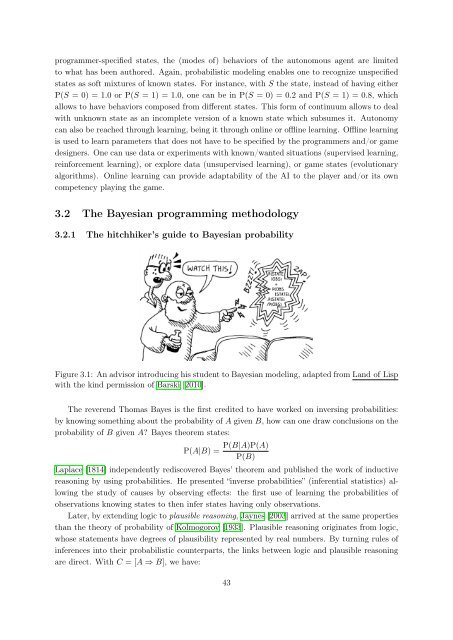Bayesian Programming and Learning for Multi-Player Video Games ...
Bayesian Programming and Learning for Multi-Player Video Games ...
Bayesian Programming and Learning for Multi-Player Video Games ...
Create successful ePaper yourself
Turn your PDF publications into a flip-book with our unique Google optimized e-Paper software.
programmer-specified states, the (modes of) behaviors of the autonomous agent are limited<br />
to what has been authored. Again, probabilistic modeling enables one to recognize unspecified<br />
states as soft mixtures of known states. For instance, with S the state, instead of having either<br />
P(S = 0) = 1.0 or P(S = 1) = 1.0, one can be in P(S = 0) = 0.2 <strong>and</strong> P(S = 1) = 0.8, which<br />
allows to have behaviors composed from different states. This <strong>for</strong>m of continuum allows to deal<br />
with unknown state as an incomplete version of a known state which subsumes it. Autonomy<br />
can also be reached through learning, being it through online or offline learning. Offline learning<br />
is used to learn parameters that does not have to be specified by the programmers <strong>and</strong>/or game<br />
designers. One can use data or experiments with known/wanted situations (supervised learning,<br />
rein<strong>for</strong>cement learning), or explore data (unsupervised learning), or game states (evolutionary<br />
algorithms). Online learning can provide adaptability of the AI to the player <strong>and</strong>/or its own<br />
competency playing the game.<br />
3.2 The <strong>Bayesian</strong> programming methodology<br />
3.2.1 The hitchhiker’s guide to <strong>Bayesian</strong> probability<br />
Figure 3.1: An advisor introducing his student to <strong>Bayesian</strong> modeling, adapted from L<strong>and</strong> of Lisp<br />
with the kind permission of Barski [2010].<br />
The reverend Thomas Bayes is the first credited to have worked on inversing probabilities:<br />
by knowing something about the probability of A given B, how can one draw conclusions on the<br />
probability of B given A? Bayes theorem states:<br />
P(A|B) = P(B|A)P(A)<br />
P(B)<br />
Laplace [1814] independently rediscovered Bayes’ theorem <strong>and</strong> published the work of inductive<br />
reasoning by using probabilities. He presented “inverse probabilities” (inferential statistics) allowing<br />
the study of causes by observing effects: the first use of learning the probabilities of<br />
observations knowing states to then infer states having only observations.<br />
Later, by extending logic to plausible reasoning, Jaynes [2003] arrived at the same properties<br />
than the theory of probability of Kolmogorov [1933]. Plausible reasoning originates from logic,<br />
whose statements have degrees of plausibility represented by real numbers. By turning rules of<br />
inferences into their probabilistic counterparts, the links between logic <strong>and</strong> plausible reasoning<br />
are direct. With C = [A ⇒ B], we have:<br />
43


